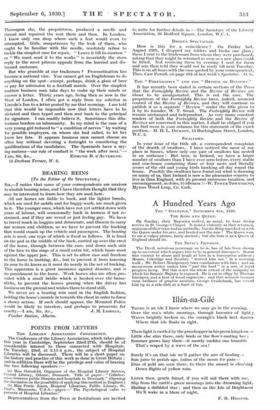BEARING REINS [To the Editor of the SPECTATOR.]
S01,-1 notice that some of your correspondents are anxious to abolish bearing reins, and I have therefore thought that they may be interested to learn how they are used here.
All our horses are liable to buck, and the lighter breeds, which are used for saddle and for buggy-work, are much given to it. The younger ones, which have not yet settled down with years of labour, will occasionally buck in harness if not re- strained, and if they are vexed or just feeling gay. We have to travel much in buggies and democrats, and therein to carry our women and children, so we have to prevent the bucking that would smash up the vehicle and passengers. The bearing rein is used, one type of which is fixed as follows. It is fixed on the pad in the middle of the back, carried up over the crest of the horse, through between the ears, and down each side of the face to the rings of a small extra bit, which bears most against the upper jaw. This is set to allow ease and freedom to the horse in trotting, Sm., but to prevent it from lowering its nose to its knees as it must do nearly in the act of bucking. This apparatus is a great insurance against disaster, and is no punishment to the horse. Work horses also are often pro- vided with a small bridle, which is hooked over the hame- sticks, to prevent the horses grazing when the driver has business on the ground and wishes them to stand still.
We never see a bearing rein used in the English fashion, holding the horse's muzzle in towards the chest in order to force a showy action. If such should appear, the Mounted Police would be likely to interfere, and perhaps to prosecute for
Pincher Station, Alberta.






























 Previous page
Previous page